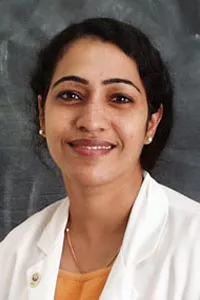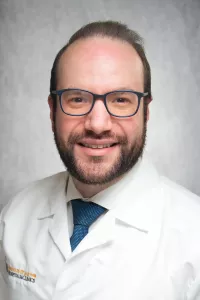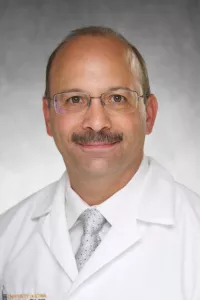Lymphangioleiomyomatosis (LAM)
- For all other requests:
- 1-800-777-8442
Finding out you have a rare lung disease like lymphangioleiomyomatosis (LAM) can feel overwhelming. But you can also feel hopeful, knowing treatments and interventions make it possible to slow or stop disease progression.
You can find these treatments at University of Iowa Health Care. We’re home to pulmonologists and other specialists with experience diagnosing and managing LAM.
We’re also recognized as a LAM clinic by the LAM Foundation, a global network of patients, providers, and researchers working to find better treatments. Through this network, you have access to clinical trials for the most promising new LAM therapies.
What is lymphangioleiomyomatosis?
Lymphangioleiomyomatosis—also known as LAM disease, or simply LAM—is a rare genetic condition that affects the lungs.
With LAM, certain cells that resemble smooth muscle cells slowly grow within your lungs. This causes your lungs to develop cysts, which get in the way of proper air flow.
People with LAM were born with mutations (abnormalities) in certain genes.
It usually occurs in people with a genetic condition called tuberous sclerosis (also known as tuberous sclerosis complex). This is an inherited condition, meaning it can be passed from a parent to their child.
Sporadic LAM occurs in people with no family history of tuberous sclerosis and are born with the gene mutation that causes LAM. It cannot be passed on to your children.
Sporadic LAM is very rare in men, it is much more common in women. Symptoms usually appear between the ages of 20 and 40.
Lymphangioleiomyomatosis symptoms often mimic other lung diseases, like asthma or bronchitis. They may include:
- Chest pain
- Chronic cough
- Shortness of breath
- Wheezing
People with LAM may also develop complications in their lungs or other parts of the body. These include:
- Pneumothorax (collapsed lung): If one of the cysts in your lungs ruptures, air escapes the lung and builds up in the space around your lungs. This can cause your lung to collapse.
- Pleural effusion (fluid buildup around the lungs): Abnormal LAM cells can invade nearby lymph nodes and lymph vessels (tubes that carry a fluid called lymph). If these cells block one of your lymph vessels, you may have fluid build-up in your chest cavity.
- Kidney tumors: Some people with LAM also develop tumors in their kidneys. These tumors, called angiomyolipomas, can become cancerous if they grow more than 3 centimeters in diameter. They can grow large enough to rupture—causing internal bleeding. They can also affect kidney function.
Diagnosing lymphangioleiomyomatosis
Because LAM has the same symptoms as many other lung conditions, it can be misdiagnosed, especially in its early stages.
Fortunately, UI Health Care offers the various tests (and expertise) needed to confirm or rule out LAM. These tests include:
- Chest CT scan: We’ll take detailed pictures of your lungs using a high-resolution CT scanner. This shows us whether you have any cysts inside (or fluid around) your lungs.
- VEGF-D blood test: This test analyzes your blood for a protein called vascular endothelial growth factor-D (VEGF-D). If you have very high levels of this protein and cysts in your lungs, we can officially diagnose LAM. In this case, you won’t need to have a lung biopsy.
- Pulmonary function test: We have you breathe into a device that measures how well your lungs work.
- Abdominal CT or MRI scan: We may take a CT or MRI scan of your abdomen to see if you have any kidney tumors associated with LAM.
- Lung biopsy: If we can’t confirm LAM through other tests, you may need a lung biopsy. This means we take small tissue samples from your lungs to examine under a microscope.
Lymphangioleiomyomatosis treatment from UI Health Care
Although there isn’t a cure for LAM yet, new treatment advances make it possible to control it. Our goals include:
- Stopping the disease from getting worse
- Improving your symptoms
- Preventing or treating complications
We offer every nonsurgical and surgical treatment for LAM. These include:
- Medication: mTOR inhibitors, including Rapamune (sirolimus) and Afinitor (everolimus), are first-line treatments for patients with reduced lung function. They can slow or stop the uncontrolled cell growth that leads to cysts and shrink kidney tumors.
- Bronchodilators: These inhaled medications help open your airways and improve air flow in your lungs.
- Pulmonary rehabilitation: Specially trained therapists teach you exercises to strengthen your lungs and improve your breathing.
- Oxygen therapy: If you routinely have low blood oxygen levels, we can prescribe supplemental oxygen therapy. You’ll have small tanks of oxygen delivered to your home. You can breathe in this oxygen as needed, through a tube that sits just inside your nostrils.
- Lung transplant: If you have severe LAM and other treatments haven’t helped, you may need a lung transplant. With this procedure, one of our transplant surgeons replaces your diseased lung(s) with a healthy donor lung.
Comprehensive care for people with tuberous sclerosis
Tuberous sclerosis, a genetic condition that frequently causes LAM, is often diagnosed in childhood. It causes noncancerous tumors to grow throughout the body and requires lifelong care.
Our pulmonologists work closely with providers from the tuberous sclerosis clinic at UI Stead Family Children’s Hospital. These pediatric providers treat patients throughout childhood and adolescence.
Once patients are old enough to switch from pediatric to adult providers, we work together to ensure a smooth transition of care.
If you already have LAM as you enter adulthood, we’ll make sure your treatments continue without interruption. And if your tuberous sclerosis has not affected your lungs, we’ll keep a close eye on your lung health. Our goal is to catch the early signs of LAM as soon as possible.
A multispecialty approach
Studies show that people with LAM do best when they’re cared for by a multispecialty team of experts.
When you choose UI Health Care for LAM treatment, your pulmonologist will oversee your treatment plan. But you also have access to other specialists who will help keep you as healthy as possible.
Depending on your needs, these specialists may include:
- Maternal-fetal medicine providers who specialize in high-risk pregnancy care. Not only can pregnancy hormones speed up abnormal cell growth, but taking medication can be risky for your baby. For these reasons, if you become pregnant, you and your baby will need extra monitoring and care.
- Thoracic surgeons who can treat a collapsed lung or drain fluid that’s built up around your lungs.
- Urologists who can monitor or treat any noncancerous tumors that grow on your kidneys.
- Heart surgeons who can remove tumors that may grow on your heart. If your LAM is caused by tuberous sclerosis, you also have a risk of heart tumors.
Our Care Team




Looking for a LAM specialist?
Locations and Offices
